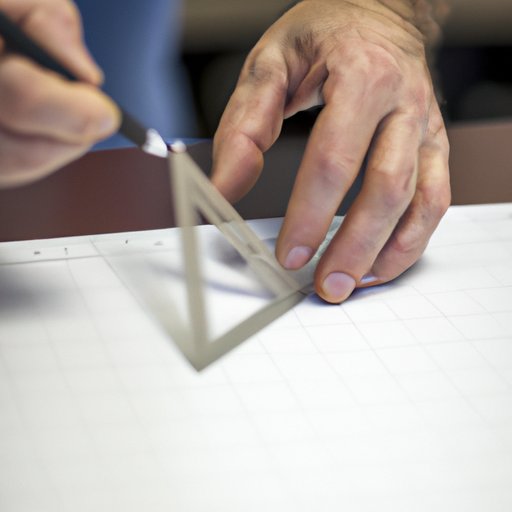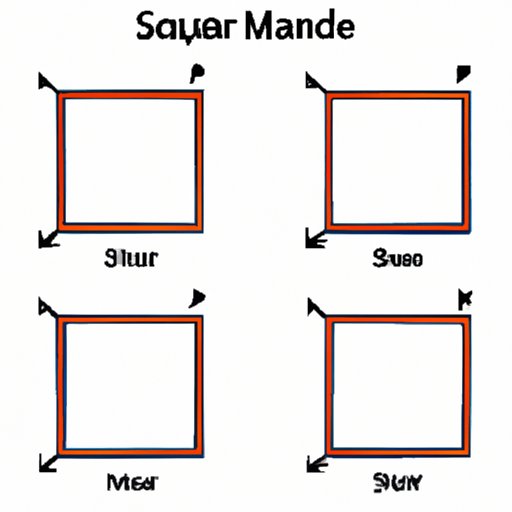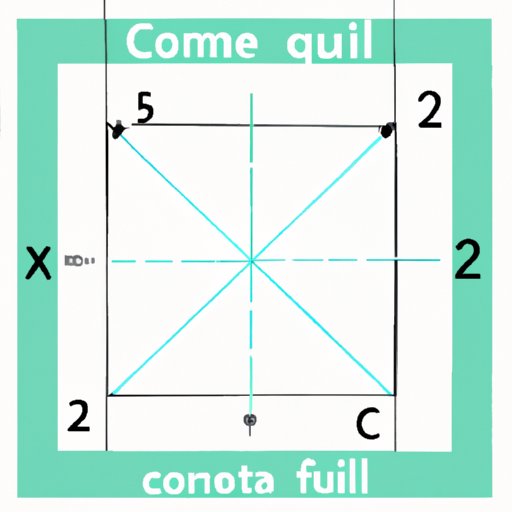Introduction
Area is a measure of space inside a shape. It is calculated by multiplying the length of each side of a shape together. When calculating the area of a square, all sides have equal length and so the area is found by squaring the length of one side. In this article, we’ll explore what it means to find the area of a square, explain the formula for calculating the area, provide a step-by-step guide on how to find the area of a square, discuss different ways to visualize and understand the area of a square, as well as look at some examples of how to apply the area of a square in real-life situations.
Explaining the Formula for Finding the Area of a Square
The area of a square is the product of its side lengths. It can be expressed mathematically using the formula A = s2, where “A” stands for area and “s” stands for the side length of the square. This formula can be used to calculate the area of any square, regardless of its size.
For example, if the side length of a square is 10 cm, then the area of the square is 100 cm2 (10 x 10). Similarly, if the side length of a square is 5 m, then the area of the square is 25 m2 (5 x 5).
Step-by-Step Guide to Calculating the Area of a Square
To calculate the area of a square, you must first measure the side length of the square. To do this, you can use a ruler, tape measure, or other measuring device. Once you have the measurement, you can use the formula A = s2 to calculate the area of the square.
For example, if the side length of a square is 12 inches, then the area of the square is 144 inches2 (12 x 12).
It is important to note that the unit of measure used for the side length must also be used for the area. So, if you measured the side length in inches, then the area must also be expressed in inches2. Likewise, if you measured the side length in centimeters, then the area must be expressed in centimeters2.

Using Online Calculators to Find the Area of a Square
There are many online calculators available that can help you quickly and easily calculate the area of a square. All you need to do is enter the side length of the square and the calculator will automatically calculate the area for you. These calculators are free and easy to use.
Using an online calculator has some advantages, such as being able to save time and not having to worry about making mistakes when calculating the area. However, there are also some disadvantages, such as not being able to practice problem solving skills or gain a deeper understanding of the concept.

Utilizing Geometry Tools to Measure the Area of a Square
Geometry tools, such as compasses and protractors, can also be used to measure the area of a square. To do this, you will need to draw a square using the geometry tool and then measure the side length of the square. Once you have the side length, you can use the formula A = s2 to calculate the area of the square.
Using geometry tools has some advantages, such as being able to practice problem solving skills and gain a deeper understanding of the concept. However, there are also some disadvantages, such as taking more time and not being able to check your work with an online calculator.

Different Ways to Visualize and Understand the Area of a Square
In addition to using formulas and tools to calculate the area of a square, it is also helpful to visualize and understand the concept in different ways. For example, you can draw diagrams to illustrate the area of a square and use other shapes to solve problems involving the area of a square. You can also explore the relationship between perimeter and area to gain a deeper understanding of the concept.
Dr. Judy Willis, a neurologist and classroom teacher, explains that “visualizing the area of a square helps students understand why the area is calculated as side length times side length.” By exploring different ways to visualize and understand the area of a square, students can gain a stronger understanding of the concept.
Examples of How to Apply the Area of a Square in Real-Life Situations
The area of a square can be applied in many real-life situations. For example, when building a fence, you can use the area of a square to calculate how much material you will need. When designing a room, you can use the area of a square to determine how much flooring you need. And when choosing a rug, you can use the area of a square to make sure the rug is the right size for the room.
Knowing how to calculate the area of a square can be very useful in everyday life. It can save you time and money, as well as help you make more informed decisions.
Conclusion
In conclusion, finding the area of a square is an important skill to have. It can be done by understanding the formula, using an online calculator or geometry tools, and visualizing it in different ways. Examples of how to apply the area of a square in real-life situations were also discussed. With the knowledge gained in this article, you should now have a better understanding of how to calculate the area of a square.
(Note: Is this article not meeting your expectations? Do you have knowledge or insights to share? Unlock new opportunities and expand your reach by joining our authors team. Click Registration to join us and share your expertise with our readers.)
